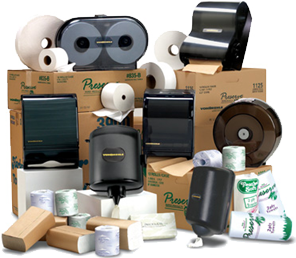Drake Thomas (President/Co-founder of CleanlyRun, formerlyCleanGuidePro) here… In my last posted article, I shared are a few observations and tips (based on my three decades in the janitorial industry) about ten typical types of janitorial customers that you may consider targeting. As promised, here’s another ten:

- HOSPITALS: Typical cleaning frequency: 3-7 days per week. Don’t let this one intimidate you. You don’t have to be a big national or regional company to get your foot in the door. You don’t need to take over the whole hospital housekeeping department to start. Take on a pressure washing job, offer stripping and waxing services to their always understaffed floor team, bid on some of their satellite clinics, offer fill in housekeepers on vacation, etc. Get with their facilities or housekeeping departments and let them know what services you have to offer. When you get work, do it perfectly and ask to bid on more. I started with one time per week floor polishing of the main cafeteria, which led to housekeepers, janitorial at their satellite clinics, trash/linen porters, full time floor techs, carpet cleaning and multiple hospitals. Pros: Lots of lucrative work. Pays well and timely (3-5 wks). Cons: Can be late nights, holidays and weekends.Requires lots of coordinating and communication with housekeeping managers. You must have your own onsite working supervisor to make sure everything goes smoothly. Requires good cash flow, but every job requires that.
- CONSTRUCTION FINAL CLEAN: This is when a Construction Company contracts you to do a one time final clean of their project, in preparation for turn over to their client owner. This could be anything from a new home they built or small bank, to a huge school or even a hospital.Typical cleaning frequency on these projects could be a 1-3 days per week to 2-3 months depending on the size. Pros: Pays well. In just about every economy there’s some projects going on to bid on. Opportunities to be a Builders first choice for future projects when you do the job right and on time. Cons: They usually pay you on a monthly draw, meaning you may have to wait 4 weeks to receive a check. If a Contractor tells you, “you get paid when I get paid”, do NOT work for him/her. A reputable Contractor receives monthly bank draws to pay suppliers and vendors monthly.
- FITNESS CLUBS: Typical cleaning frequency: 3-7 days per week. Pros: Good profit margins. Lots of gym chains popping up everywhere. Opportunity to sell them supplies, roll towels, toilet paper, etc. Carpet and floor work opportunities as well. Cons: Just late night hours or very early. Years ago, this was the “who knows when you’ll get paid customer”, but now with corporate chain ownership, they’re timely payers.
- HAIR SALONS: Typical cleaning frequency: 1-2 days per week. Pros: Salons on every corner. Cons: Not much, just hair, hair and more hair! Gets in your mops and can’t be washed out. Tip: Look for the chain of salons to bid on (as the owner of a small, single salon usually cleans the space his/herself).
- RETAIL STORES: This could be a small strip mall cell phone store to a large mall department store. Typical cleaning frequency: 3-7 days per week. Pros: Usually pays a bit more. Fast payers. Usually easy cleans. Opportunity to sell them supplies, roll towels, toilet paper, etc. Carpet and floor work will all be yours. Cons: Not much. Great accounts to have…
- MANUFACTURING PLANTS w/Production Area: Could be anything from a small manufacturing facility with a small front office (2-3000sq’) with a medium size production area (4k – 8k S.F.), to a huge front office and production area, like an auto manufacturing plant in Detroit. Typical cleaning frequency: 5-7 days per week. Pros: Very good accounts and timely payers. Cons: Again, Not much. Great accounts to have. Just possible graveyard shift start times for larger facilities.
- MEDICAL OFFICE up to 10k: Typical cleaning frequency: 3-5 days per week. Pros: Lots of medical facilities this size and 98% of the time they outsource their cleaning. Timely payers and loyal to a good janitorial company. Extra work potential and easy to staff . Usually always will buy their supplies from you. Cons: Understandably, they can be very picky at times. Requires a high level of detail cleaning and sanitizing.
- MOVIE THEATER: Typical cleaning frequency: 7 days per week. Pros:Pays well and potential for lots of floor and carpet work. Cons: Can be difficult to staff, with start times usually 1-2am. Definitely, requires working site supervisor and some working team leaders. Frequent employee callouts on this one. Tip to overcome callouts: If you need a staff of 7 each night, you hire 9 (Trust me on this one!). That way, when the inevitable callouts come, your covered and if all 9 show up, you simply get finished earlier.
- HOTEL/RESORTS COMMON AREAS: This is usually where you provide staff on 4-8 hr shifts (7am-3pm, 3pm-11pm), to clean lobbies, public restrooms, banquet rooms, etc. They’ll usually have their own housekeepers to clean and service hotel rooms.They may even contract you to clean kitchens daily. Typical cleaning frequency: 7 days per week. Pros: Any hotel account, especially national chains are excellent accounts. Opportunities to take on many more hotels. Relatively easy to staff the day and evening shifts. Usually always want you to provide floor work and carpet work. Cons: Not really a con, but you need to have a professional looking crew at all times. Nice uniforms are a must. Your staff not only needs to clean well, but also have friendly social skills and manners as they will interact with hotel staff and hotel guests.
- GENERAL OFFICE BUILDINGS over 40,000 sq’: Typical cleaning frequency: 5 days per week. Typical Square Footage: 40,000 – 90,000 Sq. Feet. Pros: This is about the same as a General Office Buildings, up to 20,000 sq’. Easy to staff, usually early start time of 5:30pm. Extra work and supplies. Good pay and usually not difficult to clean. Cons: Everyone is trying to bid this one. Winning bids need to be very competitive. Tight budgets that require great site supervision and fast production rates.
Remember, as your experience and resources increase (and they will), so will your target customers!
![]()



 When we use the term “Janitorial Supply Sales”, we’re referring to consumable janitorial products that you can sell to your customer. These are NOT the products that you pay for and provide to clean the building with, like glass cleaner, bowl cleaner, furniture polish, etc. We’re talking about the janitorial products your customer “consumes”, like toilet paper, roll towels, multi-fold towels, trash can liners, air fresheners, some chemicals and soaps.
When we use the term “Janitorial Supply Sales”, we’re referring to consumable janitorial products that you can sell to your customer. These are NOT the products that you pay for and provide to clean the building with, like glass cleaner, bowl cleaner, furniture polish, etc. We’re talking about the janitorial products your customer “consumes”, like toilet paper, roll towels, multi-fold towels, trash can liners, air fresheners, some chemicals and soaps.